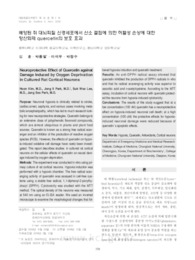

PARTNER
검증된 파트너 제휴사 자료
배양된 쥐 대뇌피질 신경세포에서 산소 결핍에 의한 허혈성 손상에 대한 항산화제 quercetin의 보호 효과 (Neuroprotective Effect of Quercetin against Damage Induced by Oxygen Deprivation in Cultured Rat Cortical Neurons)
7 페이지
최초등록일 2025.07.02
최종저작일
2009.05

-
미리보기
서지정보
· 발행기관 : 대한응급의학회
· 수록지 정보 : 대한응급의학회지 / 20권 / 2호 / 170 ~ 176페이지
· 저자명 : 김훈, 이석우, 박종일, 박정수
초록
Purpose: Neuronal hypoxia is clinically related to stroke,
cardiac arrest, asphyxia, and various cases involving metabolic
encephalopathy, which has led to much research looking
for new neuroprotective strategies. Quercetin belongs to
an extensive class of polyphenolic flavonoid compounds,
which are almost ubiquitous in plants and plant food
sources. Quercetin is known as a strong free radical scavenger
and an inhibitor of the production of reactive oxygen
species (ROS). However, the effects of quercetin on hypoxia-
induced oxidative cell damage have rarely been investigated.
This report describes studies in cultured rat cortical
neurons on the cellular effects of quercetin on neural damage
induced by oxygen-deprivation.
Methods: The experiment was conducted in vitro using primary
culture of rat cortical neurons. Hypoxia induction was
performed with a hypoxic chamber. The free radical scavenging
activity of quercetin was assayed in cell-free systems
using a stable free radical, 1,1-diphenyl-2-picrylhydrazyl
(DPPH). Cytotoxicity was studied with the MTT
method. The optical density of the neurons was measured
at 540 nm using an ELISA reader. We used an inverted
microscope to examine the morphological changes that followed
hypoxia induction and quercetin treatment.
Results: An anti-DPPH radical assay showed that
quercetin inhibited the production of DPPH radicals in vitro
and that its radical scavenging activity was superior to
ascorbic acid and n-acetylcysteine. According to the MTT
assay, incubation of cortical neurons with quercetin protected
the neurons from hypoxia-induced cytotoxicity.
Conclusions: The results of this study suggest that at a
low concentration (100 nM) quercetin has a neuroprotective
effect on hypoxia-induced neuronal cell death; at a high
concentration (100 uM) the protective effects for hypoxiainduced
neuronal damage were reduced because of
quercetin’s apoptotic effects.영어초록
Purpose: Neuronal hypoxia is clinically related to stroke,
cardiac arrest, asphyxia, and various cases involving metabolic
encephalopathy, which has led to much research looking
for new neuroprotective strategies. Quercetin belongs to
an extensive class of polyphenolic flavonoid compounds,
which are almost ubiquitous in plants and plant food
sources. Quercetin is known as a strong free radical scavenger
and an inhibitor of the production of reactive oxygen
species (ROS). However, the effects of quercetin on hypoxia-
induced oxidative cell damage have rarely been investigated.
This report describes studies in cultured rat cortical
neurons on the cellular effects of quercetin on neural damage
induced by oxygen-deprivation.
Methods: The experiment was conducted in vitro using primary
culture of rat cortical neurons. Hypoxia induction was
performed with a hypoxic chamber. The free radical scavenging
activity of quercetin was assayed in cell-free systems
using a stable free radical, 1,1-diphenyl-2-picrylhydrazyl
(DPPH). Cytotoxicity was studied with the MTT
method. The optical density of the neurons was measured
at 540 nm using an ELISA reader. We used an inverted
microscope to examine the morphological changes that followed
hypoxia induction and quercetin treatment.
Results: An anti-DPPH radical assay showed that
quercetin inhibited the production of DPPH radicals in vitro
and that its radical scavenging activity was superior to
ascorbic acid and n-acetylcysteine. According to the MTT
assay, incubation of cortical neurons with quercetin protected
the neurons from hypoxia-induced cytotoxicity.
Conclusions: The results of this study suggest that at a
low concentration (100 nM) quercetin has a neuroprotective
effect on hypoxia-induced neuronal cell death; at a high
concentration (100 uM) the protective effects for hypoxiainduced
neuronal damage were reduced because of
quercetin’s apoptotic effects.참고자료
· 없음태그
-
자주묻는질문의 답변을 확인해 주세요

꼭 알아주세요
-
자료의 정보 및 내용의 진실성에 대하여 해피캠퍼스는 보증하지 않으며, 해당 정보 및 게시물 저작권과 기타 법적 책임은 자료 등록자에게 있습니다.
자료 및 게시물 내용의 불법적 이용, 무단 전재∙배포는 금지되어 있습니다.
저작권침해, 명예훼손 등 분쟁 요소 발견 시 고객센터의 저작권침해 신고센터를 이용해 주시기 바랍니다. -
해피캠퍼스는 구매자와 판매자 모두가 만족하는 서비스가 되도록 노력하고 있으며, 아래의 4가지 자료환불 조건을 꼭 확인해주시기 바랍니다.
파일오류 중복자료 저작권 없음 설명과 실제 내용 불일치 파일의 다운로드가 제대로 되지 않거나 파일형식에 맞는 프로그램으로 정상 작동하지 않는 경우 다른 자료와 70% 이상 내용이 일치하는 경우 (중복임을 확인할 수 있는 근거 필요함) 인터넷의 다른 사이트, 연구기관, 학교, 서적 등의 자료를 도용한 경우 자료의 설명과 실제 자료의 내용이 일치하지 않는 경우
“대한응급의학회지”의 다른 논문도 확인해 보세요!
-
종격동 기형종의 자발성 파열 4 페이지
Mediastinal teratoma is a rare mediastinal tumor. Patients with mediastinal teratoma are usually asymptomatic and are diagnosed incidentally with chest radiography or CT, but they may develop symptoms.. -
응급실로 내원한 급성 심근경색증 환자에서 h-FABP (heart-type fatty acid-binding protein)의.. 7 페이지
Purpose: Heart-type fatty acid binding protein (h-FABP) is a low molecular weight (15 kDa) protein that is abundant in the cytosol and is in high concentration in the myocardium. H-FABP is released in.. -
응급실을 내원한 소아청소년에서 Visual Analogue Scale (VAS)을 이용한 통증 정도 측정의 유용성 6 페이지
Purpose: The aim of this study was to determine the reliability and validity of the Visual Analogue Scale (VAS), as a pain measurement tool in children and adolescents who visit the Pediatric Emergenc.. -
응급실 협진의뢰의 자동화가 응급실 체류시간에 미치는 영향 8 페이지
Purpose: The length of stay (LOS) for patients in the emergency department (ED) provides an important measure of both ED overcrowding and patient satisfaction. Specialty consultation is one of the maj.. -
응급실에 내원한 성인 환자들의 몸무게 추정에 있어 종아리 둘레 측정의 유용성 5 페이지
Purpose: There is no reliable body index to use in estimating adult body weight. The purpose of the study was to develop a body index that can estimate adult body weight and to perform a regression eq..
문서 초안을 생성해주는 EasyAI
